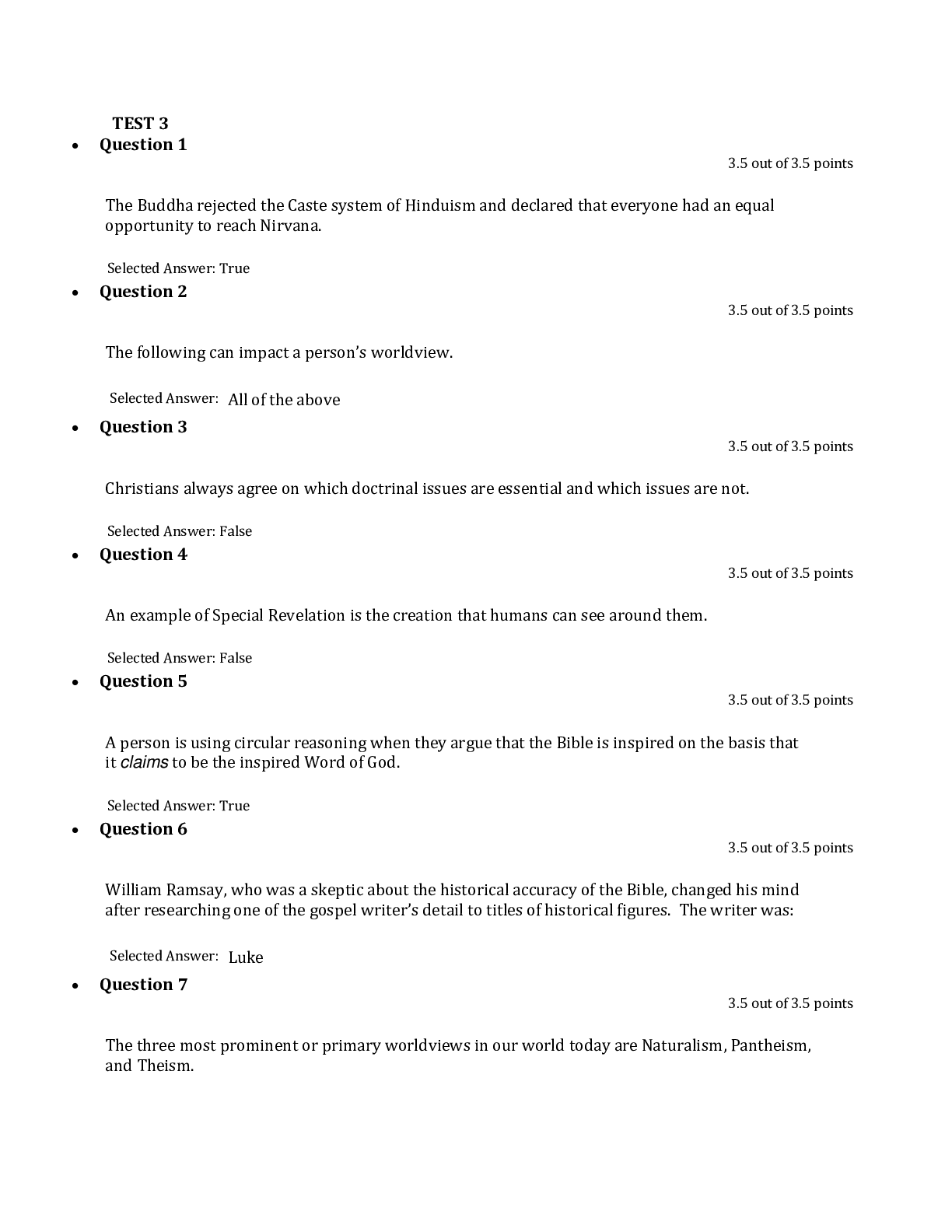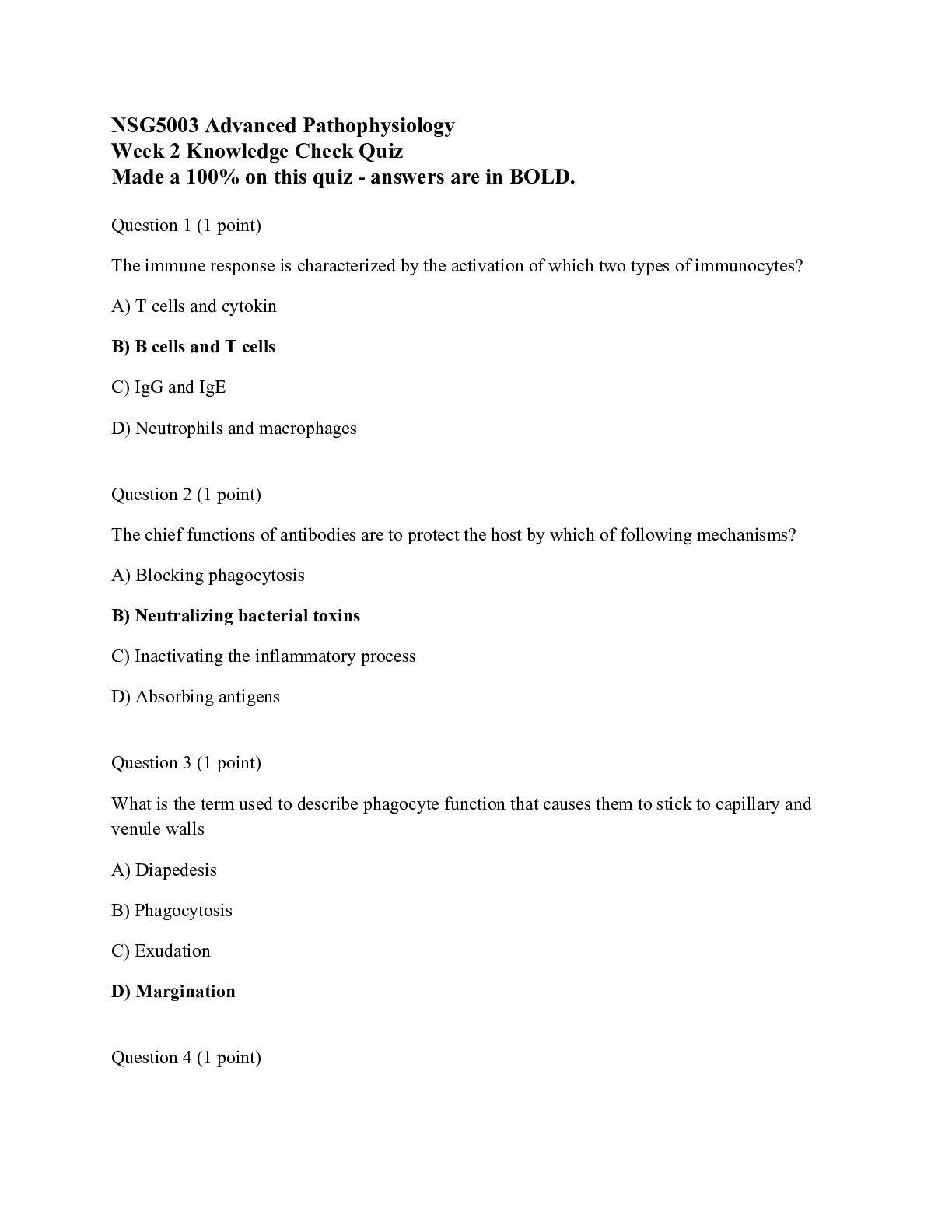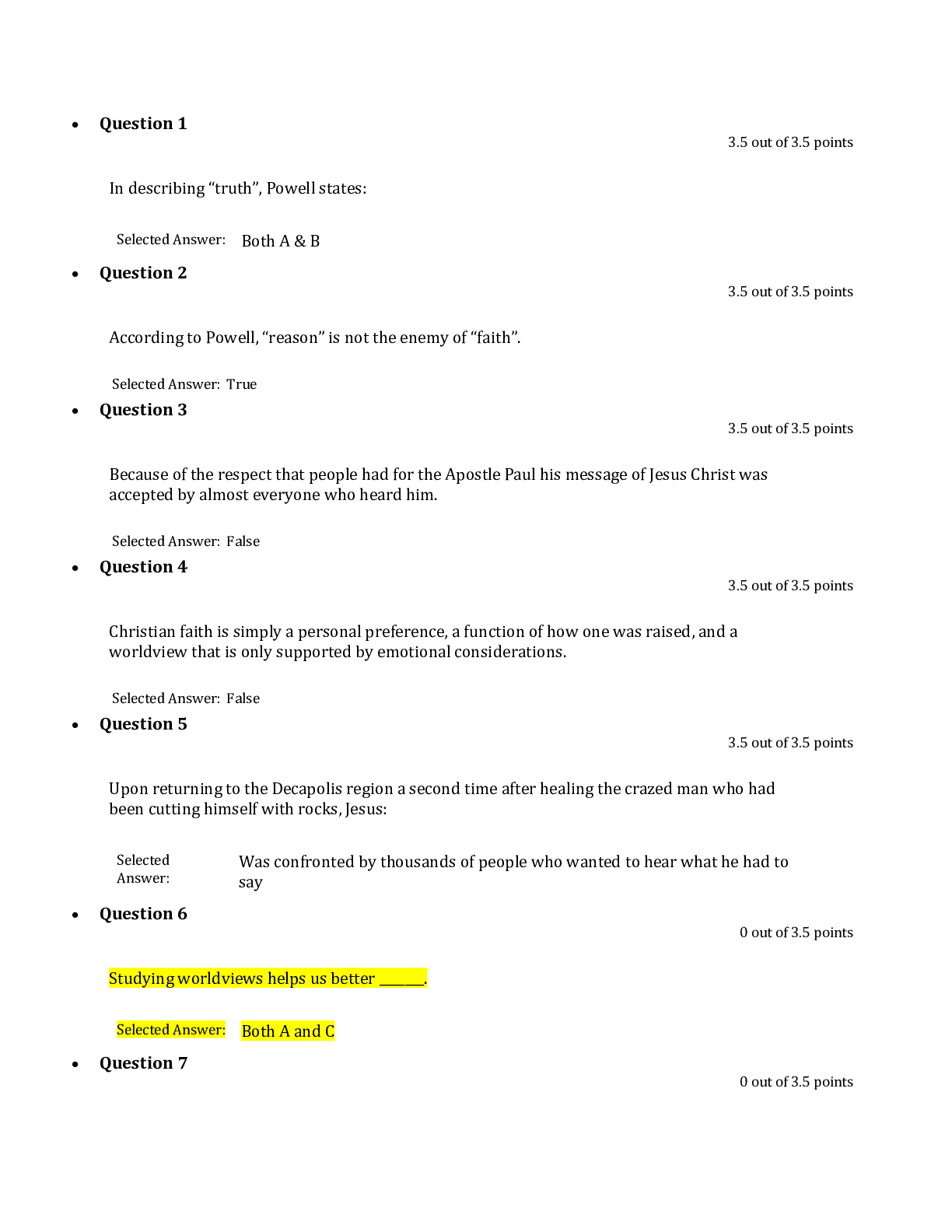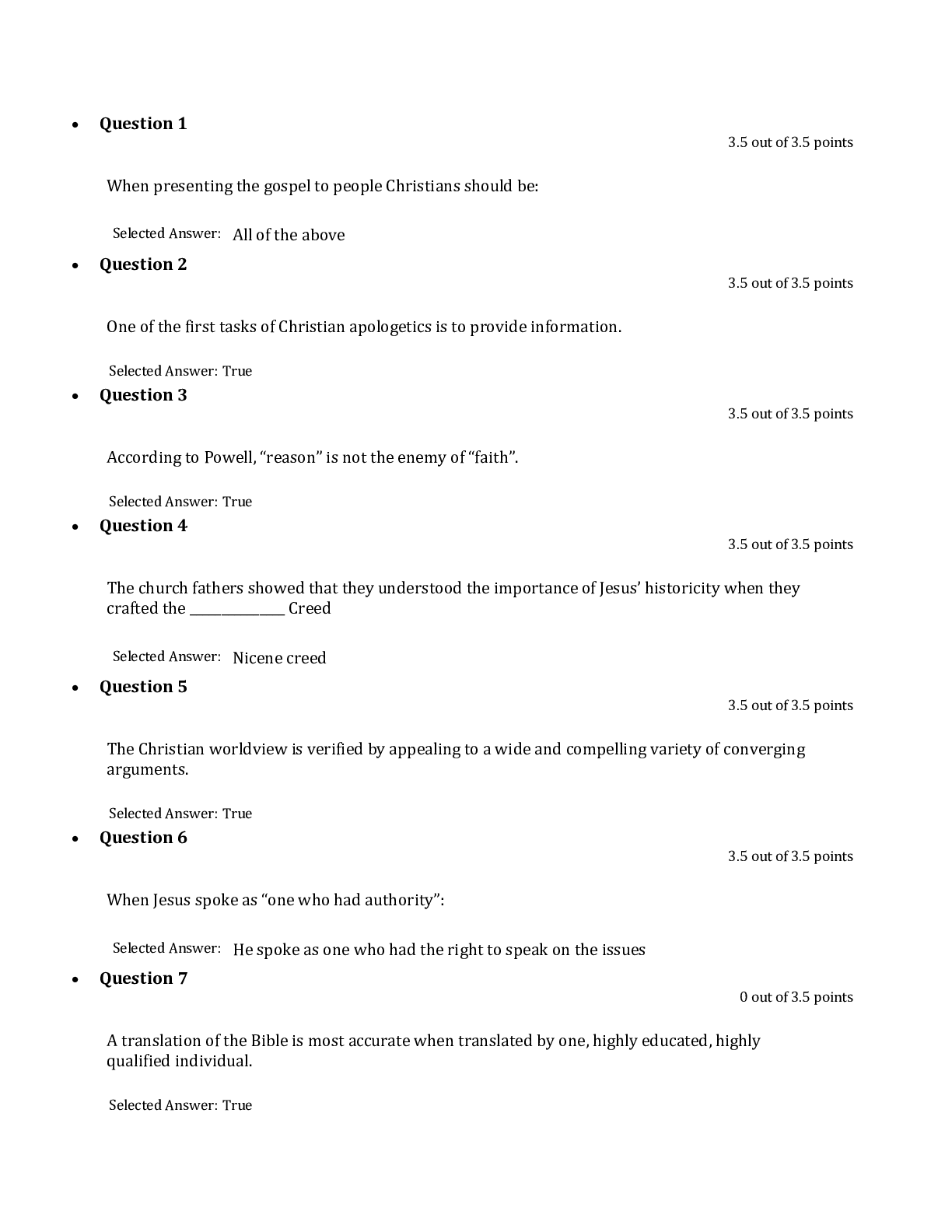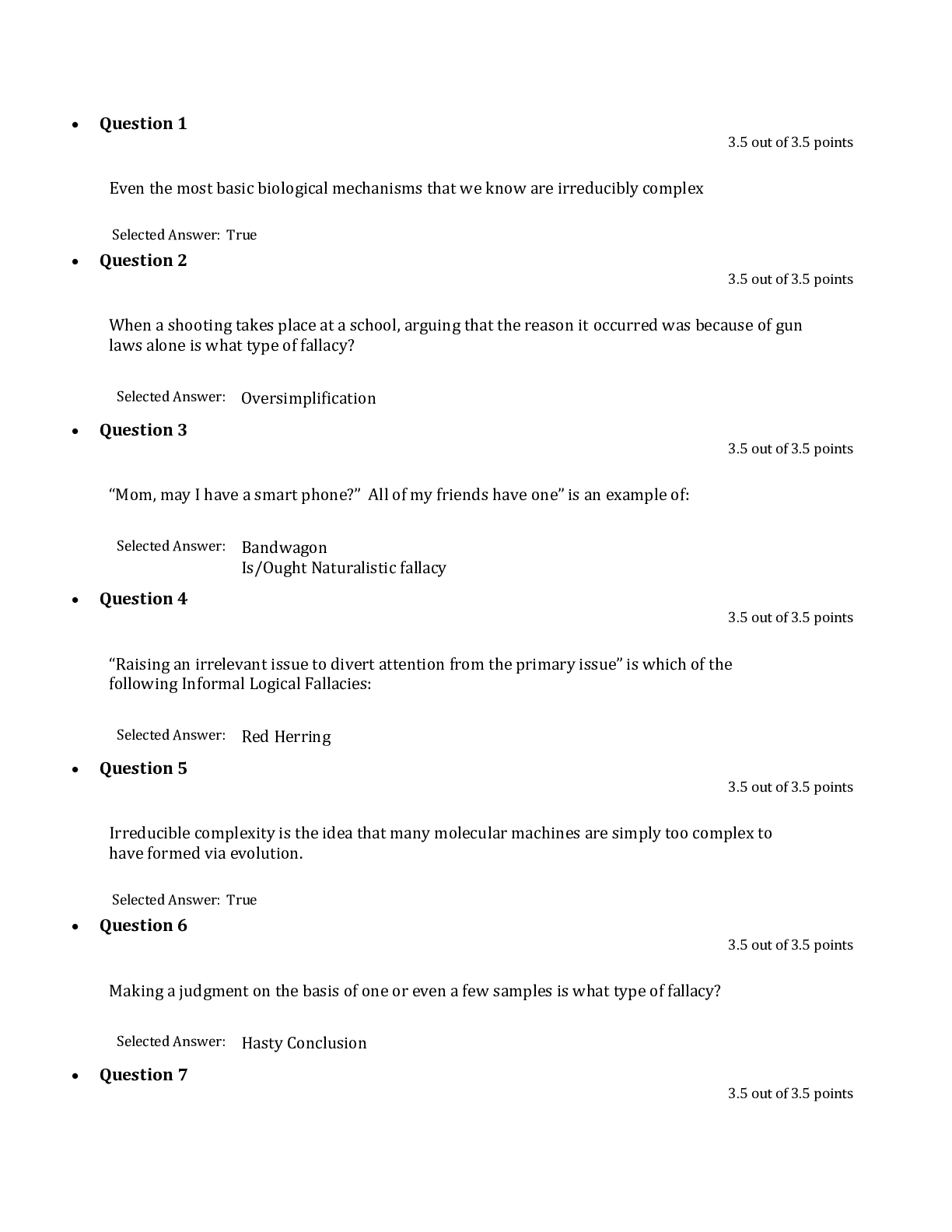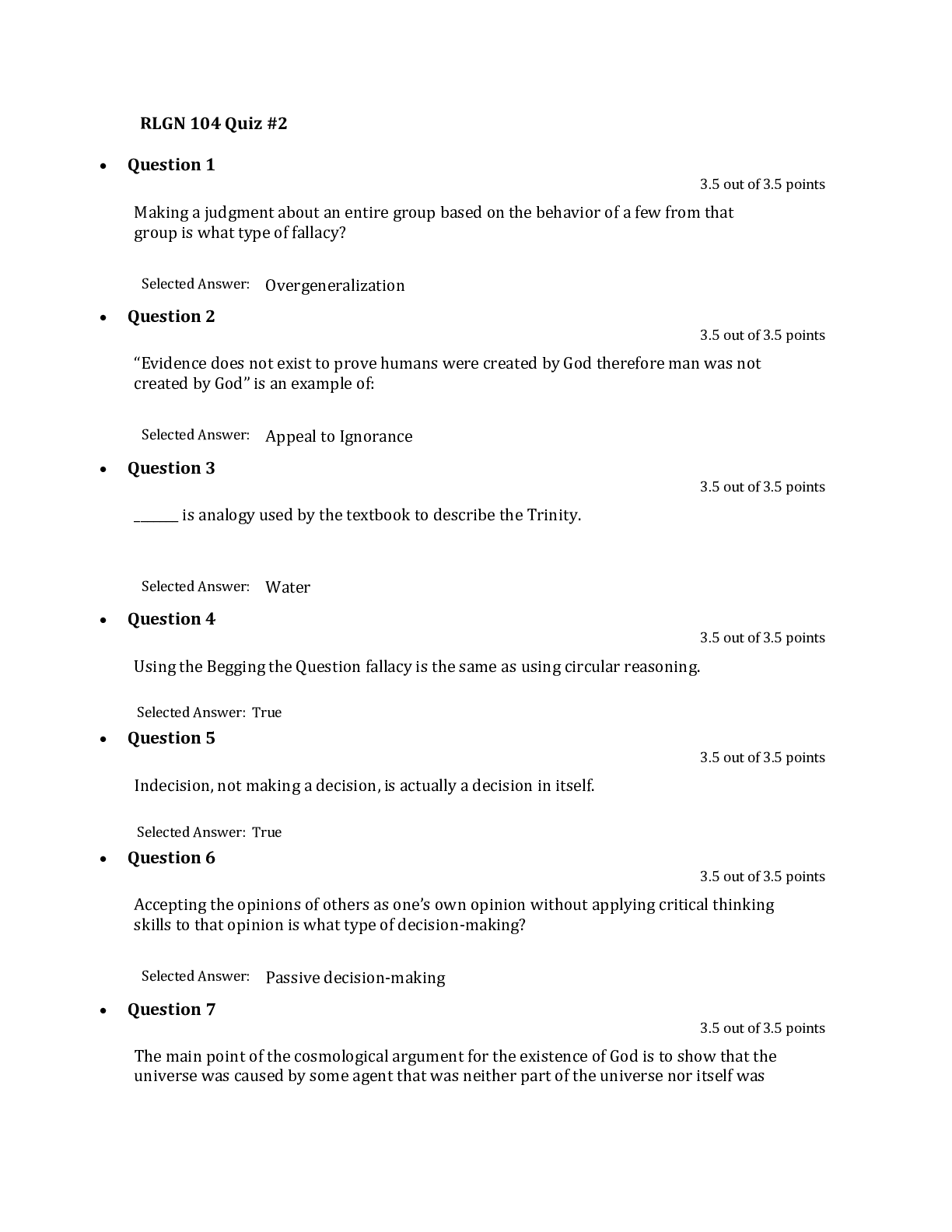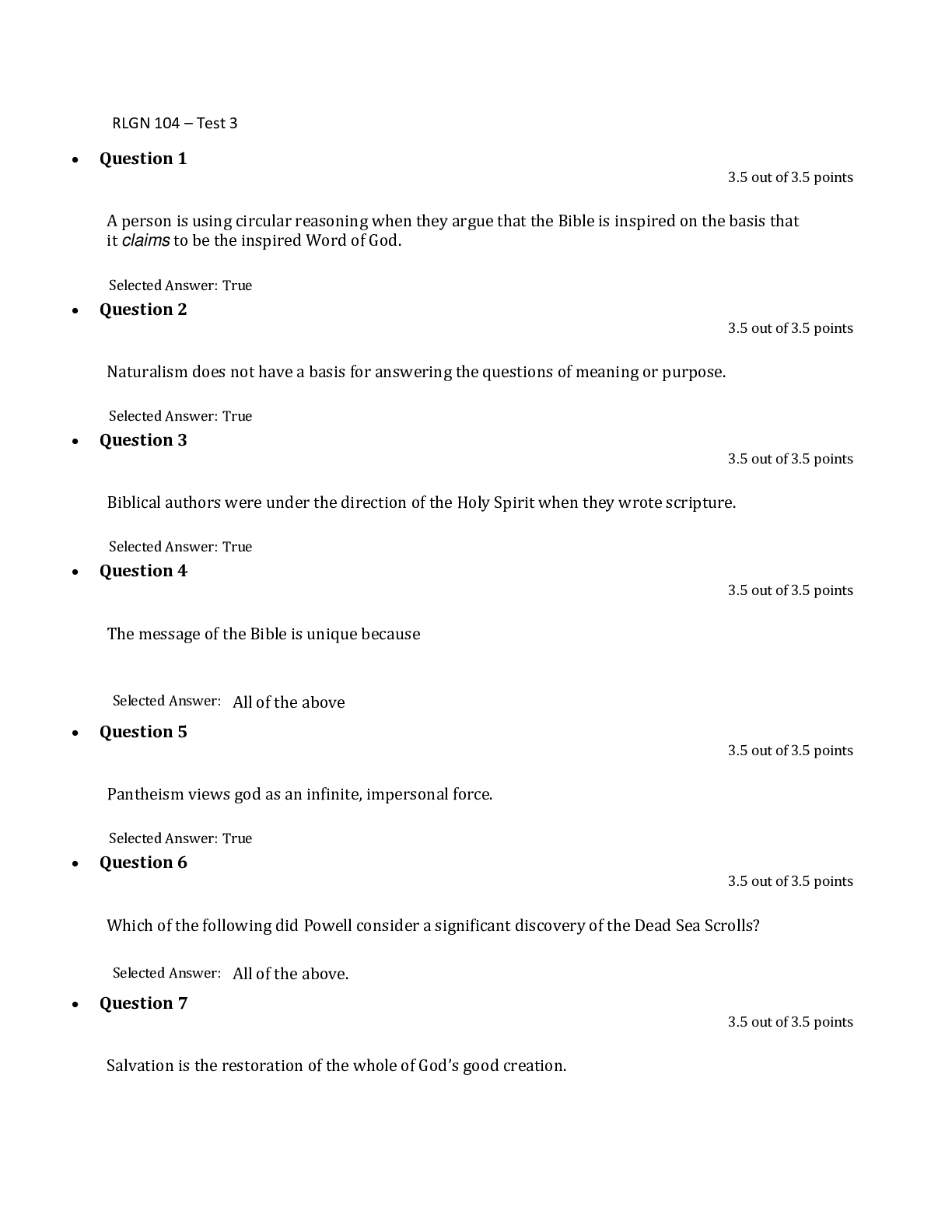*NURSING > QUESTIONS & ANSWERS > ARKANSAS TECH UNIVERSITY. SURG 001. Caring for Clients With Immune-Mediated Disorders (ALREADY GRADE (All)
ARKANSAS TECH UNIVERSITY. SURG 001. Caring for Clients With Immune-Mediated Disorders (ALREADY GRADED A)
Document Content and Description Below
Caring for Clients With Immune-Mediated Disorders 1. Your client is about to have a skin test for an allergic disorder. What critical instruction should the nurse give this client? A) Avoid red me... at for 48 to 72 hours before the test. B) Avoid strenuous physical activity for 24 hours before the test. C) Avoid antihistamines and cold preparations for 48 to 72 hours before the test. D) Avoid sunlight for 48 to 72 hours before the test. 2. The clinic nurse is caring for a client with an allergic disorder who has received the first sensitizing dose of a new drug. What nursing action is most important at this point? A) Assess the client for reduced urine output. B) Monitor the client for reactions. C) Assess the client for reduced appetite. D) Monitor the client for increased heart rate. 3. You are caring for a client with an autoimmune disease. What is a characteristic of autoimmune disorders? A) Progressive tissue damage without any verifiable etiology B) Absence of a triggering event C) Profound fatigue with no identifiable cause D) Affects only older adults and infants less than 3 months 4. You are caring for a client with chronic fatigue syndrome. What is a realistic nursing intervention when taking care of a client with this diagnosis? A) Educate the client about the disease process. B) Advise the client to avoid moderate exertion. C) Instruct the client to reduce the intake of potassium-rich foods. D) Advise the client to avoid being in crowds. 5. A client presents at the clinic with an allergic disorder. The client asks the nurse what an “allergic disorder” means. What would be the nurse's best response? A) “It means you are very sensitive to something inside of yourself.” B) “It is a hyperimmune response to something in the environment that is usually harmless.” C) “It is a muted response to something in the environment.” D) “It is a harmless reaction to something in the environment.” 6. The nursing instructor is discussing allergic reactions with her clinical group. What allergic reactions would the nursing instructor talk about? Select all that apply. A) Atypical B) Unmediated C) Cytotoxic D) Atopic E) Immune complex 7. A client has been hospitalized for diagnostic testing. The client has just been diagnosed with multiple sclerosis, which the physician explains is an autoimmune disorder. How would the nurse explain an autoimmune disease to the client? A) A disorder where the body has too many immunoglobulins. B) A disorder where histocompatible cells attack the immunoglobulins. C) A disorder where killer T cells and autoantibodies attack or destroy natural cells—those cells that are “self.” D) A disorder where the body does not have enough immunoglobulins. 8. A client with lupus has had antineoplastic drugs prescribed. Why would the physician prescribe antineoplastic drugs for an autoimmune disorder? A) To decrease the body's risk of infection B) Because an autoimmune disease is a neoplastic disease C) So the client has strong drug therapy D) For their immunosuppressant effects 9. A client with early-stage rheumatoid arthritis asks the nurse what he can do to help ease the symptoms of his disease. What would be the best response by the nurse? A) “The doctor could prescribe anti-inflammatory drugs.” B) “The doctor could prescribe antipyretic drugs.” C) “The doctor could prescribe antineoplastic drugs.” D) “The doctor could prescribe antihypertensive drugs.” 10. A client with an allergic disorder is in treatment for his disorder. What might the treatment be? A) Autoimmune therapy B) Hypersensitive therapy C) Desensitization therapy D) Drug therapy for symptoms 11. A client comes to the clinic and states he has “broken out in hives and itching since eating strawberries this morning.” The client states he has never had problems with strawberries before. What is the best response by the nurse? A) “It is probably not the strawberries that you are having an allergy to if you have eaten them before.” B) “It is possible to develop an allergic reaction to something you have had prior exposure to previously.” C) “Are you sure that you haven't had an allergic reaction before; this doesn't seem possible.” D) “We will probably be admitting you to the hospital; this could cause respiratory arrest.” 12. A client is given a dose of ketorolac (Toradol), a nonsteroidal anti-inflammatory drug for complaints of abdominal pain. Ten minutes after receiving the medication, the client's eyes, lips, and face begin to swell, and the nurse hears stridor. What priority measure should the nurse prepare to do? A) Intubate the client. B) Perform an electrocardiogram (ECG). C) Assess the client's vital signs. D) Administer epinephrine. 13. A client received 2 units of packed red blood cells while in the hospital with rectal bleeding. Three days after discharge, the client experienced an allergic response and began to itch and break out with hives. What type of reaction does the nurse understand could be occurring? A) Delayed hypersensitivity response B) Anaphylactic reaction C) Sensitization D) An immediate hypersensitivity response 14. A client comes to the clinic to see the physician with the complaint of “I think I ate something that I am allergic to.” What symptoms would be appropriate for the nurse to ask the questions about? A) Nasal congestion and coughing B) Hives and itching C) Sneezing and runny nose D) Diarrhea and abdominal cramping 15. The nurse is talking with a client who was stung by a bee and began having difficulty breathing. What serious complication from injected venom should the nurse discuss with the client? A) Hives B) Itching C) Airway obstruction D) Diarrhea 16. A client comes to the clinic and informs the nurse that he feels as though he has allergies. What laboratory test results will be a positive indicator for an allergic disorder? A) Radioallergosorbent blood test (RAST) of 3 B) WBC of 7000/mm3 C) Neutrophils 60% D) Eosinophils 6% 17. A client is scheduled to have a prick test to determine what specific allergens are creating problems for the client. What should the nurse inform the client is involved with the testing? A) A concentrated form of the substance is applied to the skin and covered with an occlusive dressing for 48 hours and then examined. B) A dilute solution of an antigen is injected intradermal and observed for a wheal. C) The skin will be scratched, and applying a small amount of the liquid test antigen to the scratch, usually on the back. D) The client will taste several different possible antigens and observe for wheals. 18. A client informs the nurse that he is very allergic to poison ivy but loves to go camping and has several camping trips planned for the summer months. What suggestions can be made to protect against poison ivy? A) Calamine lotion prior to the exposure of the poison ivy and any time skin gets wet B) Bentoquatam 5% (Ivy Block) applied 15 minutes prior to exposure and every 4 hours C) Vinegar and water applied to the skin every 2 hours D) Take diphenhydramine (Benadryl) 50 mg prior to the camping trip. 19. The nurse is interviewing a client being admitted to the hospital and inquires about any allergies the client has. The client states he is allergic to aspirin and penicillin. What intervention should the nurse provide immediately to prevent complications related to allergies? A) Apply an allergy bracelet and flag the chart. B) Tape an Epipen to the head of the bed. C) Inform the client not to take any medications with those substances in them. D) Call the physician. 20. A client has an allergic reaction to seafood with generalized edema and informs the nurse that he is unable to get his wedding ring off and it is too tight. The client was unable to remove it with soap and water. What action by the nurse can facilitate removal of the ring without damaging it? A) Administer a diuretic and wait for the swelling to go down. B) There is not another option other than to use a ring cutter to remove the ring. C) Use twine to wrap the finger and, when the tissue is compressed, pull the free end of the twine and remove the ring. D) Use a tongue blade to remove the ring. 21. A client is scheduled for diagnostic skin testing in 1 week. What should the nurse be sure to instruct the client prior to the scheduled appointment? A) Do not take prescribed or over-the-counter antihistamines or cold preparations for at least 72 hours before testing. B) Do not take antihypertensive medications the morning of the scheduled skin testing. C) Do not take nonsteroidal anti-inflammatory (NSAID) medications for 1 week prior to the scheduled skin testing. D) Prior to having the skin test, have the client take an over-the-counter histamine prophylactically for any possible reaction that could cause anaphylaxis. 22. A client has been having joint pain and swelling in the left foot and is diagnosed with rheumatoid arthritis. The symptoms began suddenly without any identifiable cause, and the client has significant joint destruction. What type of disease is this considered? A) An exacerbation of a previous disorder B) Autoimmune C) An alloimmunity disorder D) A cause-and-effect relationship 23. A client injured the left eye while playing basketball when another player hit him in the eye with his elbow. The client complained that although the right eye was not affected, he is having difficulty now with the vision in that eye too. What does the nurse understand this phenomenon is known as? A) Cataracts B) Psychosomatic blindness C) Glaucoma D) Sympathetic uveitis 24. A client with Crohn's disease, an autoimmune disorder, informs the nurse that he has not had any symptoms of the disease in 8 months. What does the nurse understand this asymptomatic period is referred to? A) An exacerbation B) Remission C) A cure D) An acute inflammatory response 25. The nurse is collecting data from a client with the autoimmune disorder, endocarditis. What does the nurse recognize as symptom of an acute exacerbation? A) Temperature of 100.9° F B) Respiratory rate of 20 breaths/minute C) Constipation D) Nausea 26. A client with rheumatoid arthritis informs the nurse that since he has been in remission and not having any symptoms, he doesn't need to take his medication any longer. What is the best response by the nurse? A) “If you don't take your medication, you will become very ill.” B) “Be sure to let the physician know after you stop your medications.” C) “It is important that you continue to take your medication to avoid an acute exacerbation.” D) “As long as you are not having symptoms, you can take a medication vacation.” 27. A client is taking a corticosteroid for the treatment of systemic lupus erythematosus. When the nurse is providing instructions about the medication to the client, what priority information should be included? A) If the client experiences nausea, omit the dose. B) The client should be alert for joint aches. C) This medication is commonly used for many inflammatory reactions and is relatively safe. D) Be alert for signs and symptoms of infection and report them immediately to the physician. 28. The nurse has four clients who are scheduled to see the physician for “fatigue” and other general symptom complaints. Which client does the nurse determine is at most risk for having chronic fatigue syndrome? A) Hispanic male, age 28 years B) Caucasian female, age 47 years C) African American female, age 42 years D) Chinese American female, age 18 years 29. A client comes to the clinic and informs the nurse that he had a mild case of the flu a couple of months ago and “hasn't felt well since.” The client tells the nurse that he is fatigued and it gets worse after any physical activity and a recurrent sore throat and joint pain. What does the nurse recognize these symptoms may indicate? A) Chronic fatigue syndrome B) Rheumatoid arthritis C) Ulcerative colitis D) Recurrent flu 30. The client is scheduled for a tilt-table test to assist in the diagnosis of chronic fatigue syndrome (CFS). What is the nurse's responsibility while the client is having the test? A) Diagnose the client's chronic fatigue syndrome. B) Position the client while monitoring the oxygen saturation. C) Perform venipuncture for glucose levels during testing. D) Position the client while monitoring blood pressure and pulse. 31. The nurse is instructing a client with chronic fatigue syndrome about what type of dietary sources are the best to eat to supply eicosapentaenoic acid (EPA). What statement by the client demonstrates the instruction is understood? A) “I will eat shrimp at least twice a week.” B) “I love crab cakes and will be sure to make them once a week.” C) “Fresh salmon is one of my favorites, and I will eat it twice a week.” D) “Lobster is expensive, but I will eat it once a week.” 32. A client presents to the clinic with complaints that he began to itch and break out in hives after taking an aspirin this morning. What medication does the nurse anticipate administering that blocks histamine receptors? A) Diphenhydramine (Benadryl) B) Flunisolide (Nasalide) C) Beclomethasone dipropionate (Beconase) D) Pseudoephedrine hydrochloride (Sudafed) 33. A client calls the clinic and asks the nurse if using Afrin nasal spray would be alright to relieve the nasal congestion he is experiencing due to seasonal allergies. What instructions should the nurse provide to the client to avoid complications? A) Report white patches in the mouth because Afrin can cause a fungal infection. B) Do not use Afrin for longer than 3 to 5 days in a row or rebound congestion can occur. C) Taper the dose when discontinuing the medication. D) Do not operate machinery or drive while using Afrin nasal spray. 34. A client is taking oral corticosteroids after having an exacerbation of asthma. What should the nurse be sure to include when instructing the client how to take the medication? A) The medication will cause weight loss. B) The medication will cause drowsiness so do not drive. C) Take the medication on an empty stomach to increase absorption. D) Take the medication in the morning with food. 35. A client is taking the immunosuppressant medication, azathioprine (Imuran), for the treatment of Crohn's disease. What statement made by the client demonstrates an understanding of the side effects of this medication? A) “I will notify the doctor if I have a fever or any other signs of infection.” B) “I will drink at least 3 L of fluid per day.” C) “I will notify the doctor if I am not having a bowel movement daily.” D) “I will stop taking my medication if I notice any side effects and then notify the doctor.” [Show More]
Last updated: 1 year ago
Preview 1 out of 17 pages

Buy this document to get the full access instantly
Instant Download Access after purchase
Add to cartInstant download
We Accept:

Reviews( 0 )
$12.00
Document information
Connected school, study & course
About the document
Uploaded On
Apr 12, 2020
Number of pages
17
Written in
Additional information
This document has been written for:
Uploaded
Apr 12, 2020
Downloads
0
Views
34













